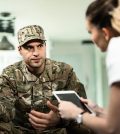- CDC Cuts Key Smoking Programs Despite Success in Curbing Smoking Rates
- RFK Jr. Touts Vaccine While At Funeral of Texas Girl Who Died of Measles
- Biden Plan To Expand Obesity Drug Coverage Is Rejected
- Most Eligible Smokers Not Getting Lung Cancer Screening
- Heart-Related Deaths More Likely During Day/Night Heatwaves
- Wildfire Smoke Increases Risk Of Mental Health Problems
- Some Folks Hit With Fees for Using Health Care Message Portals
- Diarrhea-Causing Bacteria Spreading Undetected Through Hospitals
- Ozone Pollution Increases Risk Of Childhood Asthma
- Knee Replacement Recovery Time: What You Need To Know
Making a COVID-19 Vaccine Is Tough, Distributing It Might Be Tougher

As the race to develop a safe and effective coronavirus vaccine unfolds around the globe, experts say the sheer logistics of vaccinating the masses might be even more daunting.
“The challenge we face now is really the largest and most complex mass vaccination program we’ve ever attempted,” Dr. Kelly Moore, associate director for immunization education at the Immunization Action Coalition, said during a recent HD Live! interview.
Supplies are already being marshaled to help quickly manufacture and store millions of doses of any successful vaccine, and distribution plans are being crafted to get the vaccine to the people who need it, Moore added.
During the same interview, Dr. Amesh Adalja, a senior scholar with the Johns Hopkins Center for Health Security, in Baltimore, said, “Lots of people think once you’ve gotten through the clinical trials, the vaccine is just going to magically appear in doctors’ offices, and that’s not the case. We have to think about the glass you store it in, the rubber stoppers on top, the syringes that you inject it in. We have to think about all of the supply chain elements and anticipate where things might go wrong.”
At this point, it looks like the first generation of COVID-19 vaccines will have a 50% efficacy, he noted. “That means the vaccine gives you a 50% less chance of getting infected than somebody who hasn’t been vaccinated,” Adalja said.
That might sound less than ideal, but it’s no small potatoes when dealing with a pandemic virus that’s killed hundreds of thousands, Adalja said.
“We may not, in this first generation of vaccines, get what’s called sterilizing immunity, but we may get something that modulates the severity of infection, and that would be huge,” Adalja said. “You’re less likely to be hospitalized or less likely to die. Those are still very valuable propositions with the vaccine,” he explained.
“Right now, we need something that keeps people out of the hospital and changes the course of this pandemic, so I think we can really accept something that isn’t the best vaccine but one that is good enough to get us through this acute part of the pandemic,” Adalja continued.
Operation Warp Speed, the Trump administration’s push to have a vaccine available by January, has been pouring billions of dollars into private pharmaceutical companies. The firms are using the money to gather supplies and start creating millions of doses of vaccines that haven’t yet been proven effective.
Rapid rollout of vaccine won’t compromise safety, experts say
Adalja said he’s not concerned that this pace will cause medicine to skip over crucial steps needed to protect the public health from a bad vaccine, because clinical trials are still taking enough time to gather the safety and effectiveness data needed for approval.
“What we’ve really expedited here is getting the development going, and we’ve already started thinking about manufacturing before we know whether this is going to work or not,” Adalja said. “That’s really unprecedented, because you usually wait for phase 3 clinical trial results and then you start manufacturing.”
After manufacturing comes distribution, and plans are already afoot for getting the vaccine to doctors and clinics, Moore said.
One potential complication is that it appears the COVID-19 vaccine could require two doses for full protection, Moore said.
“Anything that requires two doses is much more complicated than a one-dose vaccine program, because getting that person back in to complete their series and protect them requires an extra level of effort we didn’t have to make before,” Moore said.
Moore thinks that the yearly flu immunization program will be the “perfect warm-up game for the big game with COVID-19 next year.”
Clinics, hospitals and doctors can use the seasonal flu program to improve the way they get everyone in their practice vaccinated safely and effectively.
“It gives us practice at doing what we need to do quickly with influenza, then to focus on COVID-19 a few months from now if we’re rolling this out on a large scale,” Moore said.
Officials also are deciding who will get the vaccine first, since early on it will be in limited supply.
“One of the consistent feelings across everyone I talk to is that health care professionals should be at the front of the line. They put themselves in harm’s way occupationally in order to take care of the rest of us,” Moore said. “We need to make sure that as part of our social contract with those who put themselves in harm’s way that we make sure they’re vaccinated and fully protected so they can keep doing their jobs to take care of the rest of us.”
The groups that have shown they need greater protection from COVID-19 will also probably wind up high on the list, Moore said. Those include people in nursing homes and long-term care facilities, workers in meatpacking plants and other occupations that have faced outbreaks, and educators.
Children are very likely to be low on the list, since they do not tend to suffer life-threatening illness when they are infected with COVID-19, Moore added.
“We’re not testing these vaccines in children right now, and the priority is unlikely to be children at first,” Moore said.
More information
The U.S. Department of Health and Human Services has more about Operation Warp Speed.
Source: HealthDay
Copyright © 2025 HealthDay. All rights reserved.










